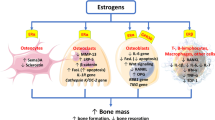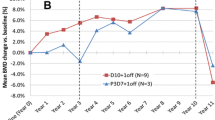Abstract:
This study aimed to assess the changes in vertebral bone mineral density (BMD) after cessation of hormone replacement therapy (HRT) in postmenopausal women who had been treated on a long-term basis. Fifty healthy postmenopausal women who had been followed both during the course of HRT and after cessation of treatment in our menopause clinic were included in this study. All women had started HRT within the first 3 years after the postmenopause and had received HRT (either 1.5 mg/day of 17β-estradiol given percutaneously or 50 μg/day of 17β-estradiol given as a transdermal patch, combined in all women with natural progesterone or a 19-norprogesterone derivative) for a mean 5 ± 2.4 years. In all women, vertebral BMD was assessed during the course of HRT up to the last 6 months before estrogen withdrawal, then at least once within the first 18 months after cessation of treatment. Of the initial population, 30 women were additionally reviewed later on and up to 8 years after cessation of treatment (mean duration of follow-up for the whole population: 3.9 ± 1.7 years). Rates of changes in vertebral BMD were compared with those determined in a group of healthy untreated women who had been followed within the first years of postmenopause during the same time period as the study population. In the study group, bone loss was found to accelerate within the first 2 years after HRT withdrawal and the annual rate of loss was identical to that which occurs within the first 2 years of postmenopause in untreated women (−1.64%± 1.3% vs −1.52 ± 0.9%, NS). Beyond this first 2-year time period, the annual rate of bone loss decreased as a function of time following cessation of treatment, as was observed following the menopause in untreated women (between 3 and 5 years: −0.83%+ 1.35% in the study group vs −0.70%± 0.8% in the control group, NS). On average, 3 years after cessation of HRT mean vertebral BMD when expressed as a Z-score was significantly higher (−0.13 vs −0.89, p<0.01) than at baseline, before HRT was started, which suggested a lasting beneficial effect on bone mass. However, even though our findings do not support the hypothesis that bone loss might continue to be accelerated several years after cessation of treatment we cannot fully address the question as to whether any residual benefit on bone mass over a longer period of time may be observed. In conclusion, the pattern of bone loss observed after cessation of estrogen therapy was found to be comparable to that which occurs in younger women within the first years after the menopause. Such a pattern needs to be kept in mind when the decision to stop HRT is taken, especially in women who were given HRT to prevent osteoporosis. The issue of assessing their risk of fracture several years after cessation of treatment thus needs to be addressed.
Similar content being viewed by others
Author information
Authors and Affiliations
Additional information
Received: 25 July 2000 / Accepted: 5 December 2000
Rights and permissions
About this article
Cite this article
Trémollieres, F., Pouilles, JM. & Ribot, C. Withdrawal of Hormone Replacement Therapy is Associated with Significant Vertebral Bone Loss in Postmenopausal Women . Osteoporos Int 12, 385–390 (2001). https://doi.org/10.1007/s001980170107
Issue Date:
DOI: https://doi.org/10.1007/s001980170107




